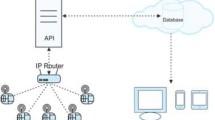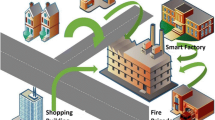Abstract
Industrial safety refers to the prevention of industrial accidents by limiting the factors that cause them. In other words, it encompasses all the activities required to safeguard and maintain industrial facilities and protect workers from all health issues caused by the disasters or accidents incurred by industrial activities. However, inadequate industrial safety education, a lack of preventative systems, and a lack of predictive facilities have led to frequent industrial accidents. These industrial accidents increase economic losses and lead to an increase also in the number of workers’ deaths and injuries. The objective of the study presented in this paper was therefore to develop a disaster prevention system to ensure the safety of workers in extreme industrial fields. In the system, peer-to-peer (P2P) sensor network technology is applied to allow the status of the worksite to be monitored in real time by the general management center, field manager, and workers in the industrial field. For the system, we developed a smartphone application that transmits the results of a harmful gas detection module and a workplace escape map, and designed a structure that connects the management center and field workers through a wireless communication repeater. In addition, we propose an integrated system that collects disaster information in real time through the P2P sensor network system. In the future, when disasters occur, the person in charge and the manager will be able to transmit information in real time, which will all owa rapid response to situations.















Similar content being viewed by others
References
Korea Occupational Safety and Health Agency (2016) http://www.kosha.or.kr
National Information Society Agency (2011) Disaster response best practices analysis for the smart age. IT Soc 7:17–25
Surendren SK, Dhamodaran S (2014) Multi-resolution pruning based co-location identification in spatial data. IOSR-JCE 16(2):1–5
Lee JI (2015) Convergent case study of research and education: Internet of things based wireless device forming research. J Korea Converg Soc 6(4):1–7
Chung KY, Park RC (2016) P2P cloud network services for IoT based disaster situations information. Peer-to-Peer Netw Appl 9(3):566–577
Kang HS, Jo DH, Kim BJ (2014) A study on the extension of smart sensor network coverage using wireless communication switching scheme. Proceedings of Symposium of the Korean Institute of Communications and Information Sciences. 374–379
A. Ahmed, K. A. Bakar, M. I. Channa, A. W. Khan, K. Has (2017) Energy-aware and secure routing with trust for disaster response wireless sensor network. Peer-to-Peer Netw Appl 10(1):216–237
Ahmed DT, Shirmohammadi S (2007) Design issues of peer-to-peer systems for wireless Ad Hoc networks. Sixth International Conference on Networking(ICN2007), pp. 26
Bok K, Kwak D, Yoo J (2012) A resource discovery with data dissemination over unstructured mobile P2P networks. KSII Transactions Internet Inf Sys 6(3):815–834
Yang B, Garcia-Molina H (2001) Comparing hybrid peer-to-peer systems, Proceedings of the 27th International Conference on Very Large Databases, VLDB, Rome, Italy
Chen Z, Shen HT, Xu Q, Zhou X (2009) Instant advertising in mobile peer-to-peer networks, IEEE 25th International Conference on Data Engineering. 736–747
Yang W, Lin B (2014) Madvertiser: a system for mobile advertising in mobile peer-to-peer environments, Proc of Pacific Asia conference on information systems, pp.133
Zen, Kartinah et al (2008) Performance evaluation of IEEE 802.15.4 for mobile sensor networks, WOCN '08. 5th IFIP International Conference on, pp. 1–5
Want R et al (1992) The active badge location system. ACM Transactions Inf Sys (TOIS) 10(1):91–102
Zhu S, Setia S, Jajodia S (2006) LEAP+: efficient security mechanisms for large-scale distributed sensor networks. ACM Trans Sensor Netw 2(4):500–528
Akyildiz IF, Su W, Sankarasubramaniam Y, Cayirci E (2002) Wireless sensor networks: a survey. Comput Netw 38:393–422
Wang Y et al (2008) Intrusion detection in homogeneous wireless sensor networks. Glob J Comput Sci Technol, Netw Web Secur 7(6):698–711
Katiyar V, Chand N, Soni S (2011) A survey on clustering algorithms for heterogeneous wireless sensor networks. Int J Adv Netw Appl 2(4):745–754
Li Z, Zhang J, Shen X, Fan J (2017) Prediction based indoor fire escaping routing with wireless sensor network. Peer-to-Peer Netw Appl 10(3):697–707
Author information
Authors and Affiliations
Corresponding author
Additional information
This article is part of the Topical Collection: Special Issue on Convergence P2P Cloud Computing
Guest Editor: Jung-Soo Han
Rights and permissions
About this article
Cite this article
Kim, BH., Kim, DI. Development of disaster prevention solution in extremely dangerous industrial environment based on P2P sensor network. Peer-to-Peer Netw. Appl. 11, 1265–1277 (2018). https://doi.org/10.1007/s12083-017-0611-3
Received:
Accepted:
Published:
Issue Date:
DOI: https://doi.org/10.1007/s12083-017-0611-3




